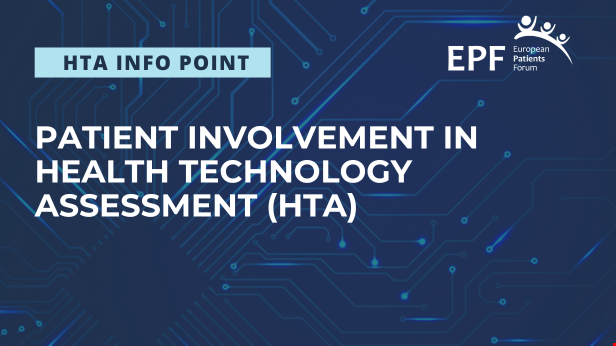Health Technology Assessment

EU Patient Involvement in Health Technology Assessment (HTA)
What is HTA about?
Health Technology Assessment (HTA) is a methodology used to evaluate how science and technology are applied in healthcare and disease prevention. It is a multidisciplinary process designed to assess the value of health technology, and guide on how it can be integrated into health systems worldwide. As defined by the World Health Organization:
''HTA is a transparent and accountable process that can be used by decision-makers and other stakeholders to support the decision-making process in health care at the policy level by providing evidence about given technologies It has been described as a bridge that connects the world of research to that of policy making.''
This evaluation covers medical, social, economic, and ethical aspects of healthcare, and provides policy-makers with objective information to formulate health policies that are safe, patient-focused and cost-effective. As a multidisciplinary tool, HTA should ideally incorporate the perspectives of patients.
HTA in the EU: the Health Technology Assessment Regulation (HTAR)
The Health Technology Assessment Regulation (EU) 2021/2282 (HTAR) enhances access to innovative technologies such as medicines and certain medical devices for patients in the EU. It establishes a coordinated, transparent framework featuring a Coordination Group of HTA authorities, a stakeholder network, and specific roles for patients and experts in joint clinical assessments.
By replacing the voluntary HTA Network and EU-funded projects with a permanent structure, the HTAR reduces redundancy, supports industry predictability, and ensures the sustainability of HTA efforts across the EU.
To learn more, see below a list of resources on HTA in Europe and the HTAR:
- HTA 36O° Report
- HTA Simulation Workshop Report
- EPF Response to the Draft Implementing Act on JCA for Medicinal Products
- EPF Response to the Draft Implementing Act on Conflict of Interest
- EPF Response to the Draft Implementing Act on HTA Collaboration with EMA
- 10 Key Recommendations from Patient Organisations
on Joint Clinical Assessments under the EU HTA Regulation - EUCAPA is a learning platform created to provide patients and patient experts with the adequate knowledge and skills to effectively participate in the HTA process. Visit the website and sign up for their training!
Key Steps
2025
June 2025:
EPF’s published its feedback on the implementing act on joint clinical assessments of medical devices and in vitro diagnostic medical device
2024
November 2024:
- EPF published its reaction to the draft Implementing Act on Joint Scientific Consultations on Medical Devices and In Vitro Diagnostic Medical Devices
October 2024:
- EPF published its reaction to the draft Implementing Act on Joint Scientific Consultations on Medicines
July 2024:
- EPF published its feedback to the Implementing Act on HTA cooperation with the EMA
June 2024:
- EPF published its Response to the Draft Implementing Act on Conflict of Interest from the European Commission
- EPF published 10 Key Recommendations from Patient Organisations on Joint Clinical Assessments under the EU HTA Regulation
2023
December 2023:
- EPF hosted an HTA Simulation Workshop. The invited participants included European patient organisations representing specific diseases and national umbrella organisations.
2018
May 2018:
- EPF published its position statement on HTA.
2017
January 2017:
- Based on the views of its members’ group, EPF contributed to the public consultation on the future of the EU cooperation on HTA. EPF's response calls for mandatory participation with mandatory uptake of joint work.
Research on Patient Involvement in HTA
Having identified the need for patient organisations to be meaningfully involved in HTA, in 2010 EPF started investigating different solutions to integrate the patient perspective.
Initiative’s Objectives
EPF’s research aimed to understand the involvement of lay patients, informal carers and patient organisations in all the EU member states, and to contribute this knowledge to inform research, policy, and practice about HTA. The outcome of this work was a good practice toolkit shared with HTA agencies, patient organisations and decision-making bodies in the EU.
Methodology
The research involved consultation with three main groups of stakeholders:
- 1st phase - HTA agencies: from the first phase of the research, it emerged that very few HTA agencies currently involve and integrate patients’ perspectives in their work. Apart from financial resource constraints, the main challenges are perceived to be the lack of capacity, time and good methodologies to involve patients. Above all, the question of the exact stage of HTA where patient engagement is needed or is most useful is still being debated but the respondents have said that ideally, they would like to improve patient involvement in the first phases of HTA.
- 2nd phase - HTA appraisal committees and decision makers: the research made on decision-makers clearly illustrates the need for EPF to continue advocating for patient involvement in HTA. Although involving patients is in general considered beneficial, the bodies or institutions in charge of decision-making on health technologies do not always do it. Often, when there is some form of patient involvement, it is not carried out in a systematic, comprehensive, and meaningful way.
- 3rd phase - Patient organisations: the third phase confirmed that patient organisations are poorly, or not involved at all, in both aspects of HTA and decision-making. They are not sufficiently involved in stages like scoping and prioritisation, where decisions about which treatments to assess and what aspects are made. Without this early involvement, there is a serious risk that available treatments will not respond to patients’ needs, and that crucial needs remain unmet.
Through surveys and discussions, EPF collected views, needs, ideas and expectations in shaping the role and scope of patient involvement in HTA processes.
Related Information
EPF Position Statement on HTA - May 2018
EPF Briefing on HTA in the EU - February 2018
EPF Response to HTA Consultation - January 2017
Final Report: EPF survey on HTA (2013)
Report: EPF survey on HTA agencies
Report: EPF survey on patients' organisations
Report: EPF survey on decision makers

